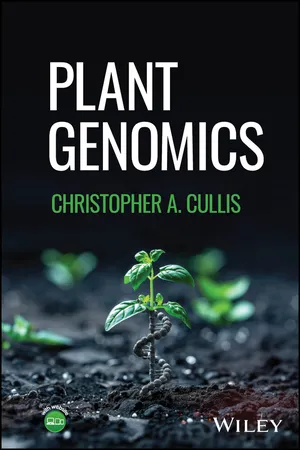Plant Genomics
About this book
Introduction to the range of molecular techniques to investigate unique facets of plant growth, development, and responses to the environment
Plant Genomics introduces the complex relationship between the genome, microbiome, genes, and epigenetics of plants, as well as the range of molecular techniques applicable to investigating the unique facets of plant growth, development, and response to the environment. State-of-the-art science in the field is discussed, as well as future outlooks on what the next decade is likely to bring.
This book includes new techniques for modifying the plant genome and their impact on modifying plants to combat the impact of biotic and abiotic stresses, including those associated with climate change, new technologies including long and short read sequencing and proximity ligation and the combination of these technologies for assembling sequence data into chromosomes, a new chapter on the sequences of the chloroplast and mitochondrial genomes, and a dedicated chapter to epigenetics and the importance in gene regulation.
Written by a highly qualified author with significant published research contributions to the field, Plant Genomics includes information on:
- Structure and information content of the chloroplast and mitochondrial genomes and their use in phylogeny
- Use of transcriptomes from various tissues to identify expressed sequences and their identification as genes
- Function of small regulatory RNAs and long non-coding RNAs and involvement of small RNAs in the control of gene expression
- Epigenetic silencing of transposable elements and their release by stress and cross-generational contribution of epigenetic variation
- Use of the pan-genome to assemble a comprehensive germplasm for a particular crop species
Plant Genomics is an ideal textbook for undergraduate courses on plant biology, particularly those focusing on molecular descriptions, and a helpful auxiliary text to plant biology laboratory courses. It will also be of interest to students in plant molecular biology, agricultural and food sciences, and plant, food, and crop bioengineering.
Frequently asked questions
- Essential is ideal for learners and professionals who enjoy exploring a wide range of subjects. Access the Essential Library with 800,000+ trusted titles and best-sellers across business, personal growth, and the humanities. Includes unlimited reading time and Standard Read Aloud voice.
- Complete: Perfect for advanced learners and researchers needing full, unrestricted access. Unlock 1.4M+ books across hundreds of subjects, including academic and specialized titles. The Complete Plan also includes advanced features like Premium Read Aloud and Research Assistant.
Please note we cannot support devices running on iOS 13 and Android 7 or earlier. Learn more about using the app.
Information
Table of contents
- Cover
- Title Page
- Copyright Page
- Contents
- About The author
- Preface
- Acknowledgments
- About the Companion Website
- Introduction
- Chapter 1 the Structure of plant Genomes
- Chapter 2 Basic Toolbox
- Chapter 3 Sequencing and assembly Strategies For large Complex Genomes
- Chapter 4 the Organelle Genomes
- Chapter 5 Gene Discoveryparadigms
- Chapter 6 Control of gene Expression
- Chapter 7 Epigenetics
- Chapter 8 Functional Genomics
- Chapter 9 the Microbiome
- Chapter 10 Interactions With the External Environment
- Chapter 11 Complex Character Manipulation—plant Breeding
- Chapter 12 Genetic Manipulation of the Plant Genome
- Chapter 13 Bioethical Concerns and the Future of plant Genomics
- Index
- EULA
